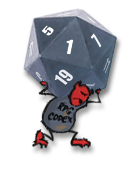-
Welcome to rpgcodex.net, a site dedicated to discussing computer based role-playing games in a free and open fashion. We're less strict than other forums, but please refer to the rules.
"This message is awaiting moderator approval": All new users must pass through our moderation queue before they will be able to post normally. Until your account has "passed" your posts will only be visible to yourself (and moderators) until they are approved. Give us a week to get around to approving / deleting / ignoring your mundane opinion on crap before hassling us about it. Once you have passed the moderation period (think of it as a test), you will be able to post normally, just like all the other retards.
You are using an out of date browser. It may not display this or other websites correctly.
You should upgrade or use an alternative browser.
You should upgrade or use an alternative browser.
Ultima The Ultima Underworld I & II Thread
- Thread starter Saxon1974
- Start date
- Joined
- May 13, 2009
- Messages
- 28,841
![The Year of Incline [2014] Codex 2014](/forums/smiles/campaign_tags/campaign_incline2014.png)


So, I've finished the Ultima Underworld.
Congratulations. It's obvious by the wall o' text you wrote that you enjoyed it. Welcome to the club.
There technically is no quest related to the spider, it's more like the goblins telling you of a nearby landmark - one that has eight legs and a voracious appetite. Basically if you killed a wolf spider (red 'un) on the first floor, then you've solved their "problem", but I don't recall them having any reward or even dialogue for it.I didn't manage to solve the black goblins' problem with a spider, I never made the stew, I don't know what some clues meant (Is and Ts, given by Biden), and I never found a certain key (to the Evil Dead at level 7).
The stew is love, the stew is life! Also essential to a quest line that leads to a very useful item. Something to look forward to in a future playthrough.
The "T's and I's"-puzzle is one of the more sneakier ones. It's the game telling you in what order the gold and silver levers are to be pulled at the end of that puzzle section you mentioned in a screenshot or two.
Last edited:
Kweepa
Literate
- Joined
- Nov 19, 2024
- Messages
- 23
Anyone interested in playing my WIP? It's mostly feature complete so I'd be interested to hear what you think.
You just need to unip, then copy the crit/cuts/data/sound folders from a gog install into the same folder as the exe. I'm not sure if it works with other versions of the game because I have done some object index specific hacks.
(You also need an xbox controller or equivalent.)
https://drive.google.com/file/d/1zT5oyN8UomdQ6-hCoDjnC8IjGaVUOZpr/view?usp=sharing
You just need to unip, then copy the crit/cuts/data/sound folders from a gog install into the same folder as the exe. I'm not sure if it works with other versions of the game because I have done some object index specific hacks.
(You also need an xbox controller or equivalent.)
https://drive.google.com/file/d/1zT5oyN8UomdQ6-hCoDjnC8IjGaVUOZpr/view?usp=sharing
behold_a_man
Educated
- Joined
- Nov 26, 2022
- Messages
- 264
I don't know any better technique for whacking fire elementals than lightning them up. And usually it took most of my mana, so I had to go to sleep afterwards. I expected the last level to contain something interesting, so I searched it carefully, but there were only elementals, armour I couldn't even wear with my limited strength, and some trinkets - so in hindsight, it wasn't worth it.Wait... 45 days? The heck???
This puzzle is very easy to brute-force, though. Note thatThe "T's and I's"-puzzle is one of the more sneakier ones. It's the game telling you in what order the gold and silver levers are to be pulled at the end of that puzzle section you mentioned in a screenshot or two.
C++:
#include <stdio.h>
#include <chrono>
#include <random>
const int SOLUTION_LENGTH=5, ATTEMPTS=1000000, ATTEMPT_LENGTH=25;
int counter[1<<SOLUTION_LENGTH];
int main(){
std::mt19937 rng(std::chrono::steady_clock::now().time_since_epoch().count());
int res=0;
for (int i=0; i<ATTEMPTS; i++){
long unsigned attempt=rng()%(1<<ATTEMPT_LENGTH);
int current=0;
for (int j=ATTEMPT_LENGTH-1; j>ATTEMPT_LENGTH-SOLUTION_LENGTH; j--){
current <<= 1;
current = current + (((1<<j)&attempt)?1:0);
}
for (int j=ATTEMPT_LENGTH-SOLUTION_LENGTH; j>=0; j--){
current = ((current<<1)&((1<<SOLUTION_LENGTH)-1)) + (((1<<j)&attempt)?1:0);
counter[current]++;
}
for (int j=0; j<(1<<SOLUTION_LENGTH); j++){
if (counter[j]) res++;
}
for (int j=0; j<(1<<SOLUTION_LENGTH); j++) counter[j] = 0;
}
printf ("%lf\n", 1.0f*res/ATTEMPTS);
return 0;}
Last edited:
Cael
Arcane

- Joined
- Nov 1, 2017
- Messages
- 22,472
I use a technique called "Caliburn to the face". It works admirably.I don't know any better technique for whacking fire elementals than lightning them up. And usually it took most of my mana, so I had to go to sleep afterwards. I expected the last level to contain something interesting, so I searched it carefully, but there were only elementals, armour I couldn't even wear with my limited strength, and some trinkets - so in hindsight, it wasn't worth it.Wait... 45 days? The heck???
behold_a_man
Educated
- Joined
- Nov 26, 2022
- Messages
- 264
50 random presses yield ~32.79 distinct binary strings. Still manageable, I guess (it must be manageable since I did pretty much exactly that).I like that you calculated that.The sequence is length 6. How does that affect your math?
Inec0rn
Educated
- Joined
- Sep 10, 2024
- Messages
- 298
I just did a playthrough, I thought I was close to beating this back in the day but alas i needed hints and don't think i ever would have solved 1 or 2 of them. The random secret wall for the blade talisman and cup are ridiculously obtuse. It's a masterpiece game though, if only more developers made games like this. So many innovations and firsts in this game, I can't believe 30 years later developers can't make games as good as these looking glass titles from the early 90's..
Kweepa
Literate
- Joined
- Nov 19, 2024
- Messages
- 23
"Sword in two pieces broken is. Wizard took haft below. Ossikka clue to blade found, he said. Blade somewhere in our domain is, I think. More than that I do not know."
"Ghastly ones broken haft have. Search for Blade in southeast. Behind wall, secrets are."
It's a little vague but not too bad I think...
"Ghastly ones broken haft have. Search for Blade in southeast. Behind wall, secrets are."
It's a little vague but not too bad I think...
behold_a_man
Educated
- Joined
- Nov 26, 2022
- Messages
- 264
The biggest 'tip' for me was"Sword in two pieces broken is. Wizard took haft below. Ossikka clue to blade found, he said. Blade somewhere in our domain is, I think. More than that I do not know."
"Ghastly ones broken haft have. Search for Blade in southeast. Behind wall, secrets are."
It's a little vague but not too bad I think...
the slope leading straight into a wall with no continuation in the southeast part of this level.
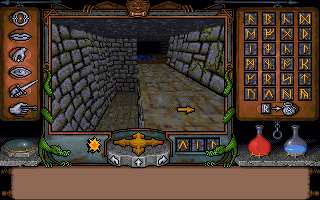
All I needed was to search for a secret door nearby.

All I needed was to search for a secret door nearby.
Baron Dupek
Arcane
behold_a_man
Educated
- Joined
- Nov 26, 2022
- Messages
- 264
I've finished Labyrinth of Worlds:
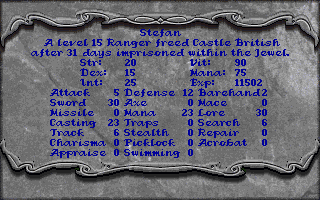
The game had a small overhaul to accommodate formerly useless skills. Search was much more meaningful this time, as buttons, levers, and things of that nature can be missed without it. The swimming sections were longer, as if attempting to make swimming less of a garbage skill, I guess. The player might doom himself with the lack of Lore, as a certain quest item is disposable and very scarce. On the other hand, repair was invalidated by a spell. While money was made a bit more significant with steep prices for certain items or information, it still wasn't a concern - and so charisma and appraise can be disregarded.
Combat-wise, Labyrinth had a few changes, such as the addition of boss encounters, like Three Companions or Dorstag. I adored the fact that they went by the same rules as regular enemies when it made sense - for example, all human enemies could be dispatched rapidly with the Poison Weapon spell. I could use the environment against enemies - for example, I killed a few yetis by luring them towards the thin ice. One unfortunate (albeit seldom important) aspect of the game is the addition of cooldowns for some spells, including magic wands.
This time around, the game featured 8 varied worlds, each with some bit of backstory and at least two things to find. The environments had more quirks - I could slide uncontrollably on ice, I could use (or be forced to use) a trampoline - a lethal endeavour in the world of Talorus, some platforms were moving or disappearing, people reacted to illicit behavior, and traps were more deadly, like the ones on the third level of the Tomb. The platforming became a bit more bearable since the Avatar doesn't fall like a rock anymore after hitting the ceiling. Also, the game became much less compact, and backtracking was a less prominent part of the gameplay. I think this game missed the Gothic-like coziness of the original - I didn't memorize most locations (since I didn't need to), and I couldn't really conquer some environments (as most traps were immutable). Some music tracks were tied to locations, but most were duplicates, and the soundtrack was overall inferior to that of the previous title (also, the main theme was way more cheerful).
There were a few other interesting developments in terms of exploration-related spells. Portal allowed me to faze through walls; gate travel worked on the Mark/Recall principle (since there were two moonstones this time, one teleporting to another). With those few additions and some major changes in level design, the optionality shone far, far brighter than in The Stygian Abyss. In the Ethereal Void, for example, one can solve all four dimensions or circumvent the entire level (except two of the gates for different quests) by using Portal spell while flying up to the shrine. I could avoid a boss fights in the Tomb of Praecor Loth. Concerning the penultimate encounter of the game, I could beat Mors Gotha by destroying the keep she's in. I could get to her room by opening the door (and angering guards) or portalling there and fighting her in isolation. I could start the combat, take the book, and teleport away. Additionally, if I already brutalized the keep,
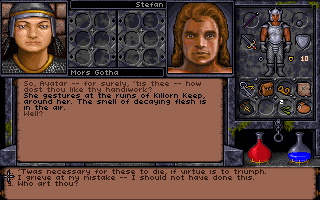 . Generally, NPCs were reactive to what I did.
. Generally, NPCs were reactive to what I did.
Given the above, it's disappointing most of the game's content was gated. Even worse, it was gated behind seemingly unrelated plot developments - for example, the last two locations were only available after
. I detested the plot in Castle British, with mundane problems of bewitched commoners (formerly Guardian's implements, sure enough - funnily, even after
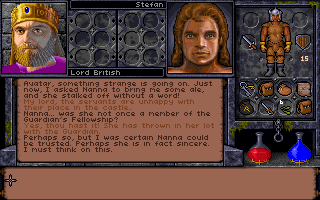 , those peasants said I struck a mighty blow for
, those peasants said I struck a mighty blow for
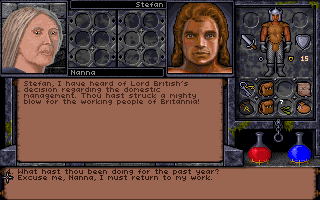 ), with a detective mystery that solves itself, with dialogues leading nowhere. The minor stories in other worlds were alright, though.
), with a detective mystery that solves itself, with dialogues leading nowhere. The minor stories in other worlds were alright, though.
This game went away from the data hunt of previous titles, as the quests became way more shallow - instead of "do X to get Y to give it to Z to get Ω", they had clearly defined start and end. Most of them concern a single area, with no detours needed. I enjoyed the fact that almost every plot-related item is possible to get without solving any of them (since you almost never get them from NPCs). As quests became more straightforward (like finding 8 gems or finding 8 places), the focus shifted from "what to do" to "how to do something". One, however, was completely out of whack - the Basilisk Oil quest.
1) In practice, this item was mentioned once in the game - and I can't ask the quest giver what it is.
2) Turns out, it's a potion - one I can't buy from the potion trader.
3) Apparently, there are four instances of this potion in the entire world.
4) Lore (or Name Enchantment) is needed to identify it.
It was disappointing. I found it while running around the world for hours, searching for things I missed (I expected it to be a quest item or some special flask of oil). It's silly, since quests are far less esoteric than the last time - but this one is way more insane than the spiritual quest from the Stygian Abyss. One thing I enjoyed while searching the world was that a lot of NPCs
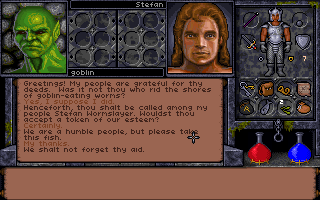
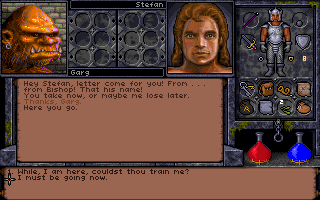 , even when there was seemingly no reason to return to them.
, even when there was seemingly no reason to return to them.
Other than that, the game went further with mapping, this time allowing me to copy fragments of found maps (though I disliked how it disallowed me to annotate those fragments), sometimes limiting my ability to map (see Ethereal Void), scarcely changing my position, forcing me to use the Locate spell. Playing as a regular mage was more feasible as the encumbrance limits were higher, and you get ten runes at the start of the game - but hunting the rest of them remained a focal point of the game. Still, like before, I don't think playing with no investments into mana/casting is feasible, since interactivity is centered around spells (unless already knowing what the game has in store for you). While the undergrounds of the castle didn't pull any punches from the start, with reapers, beholders, and headlesses roaming around, the other levels contained challenges homogenous in difficulty, seldom exceeding the Avatar's current abilities - contrary to
 . Portraits were prettier and more diverse, but I didn't feel like the game was a big upgrade graphically, and I think the monsters sometimes got uglier - here is a
. Portraits were prettier and more diverse, but I didn't feel like the game was a big upgrade graphically, and I think the monsters sometimes got uglier - here is a
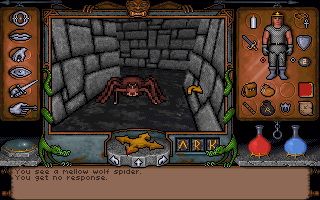
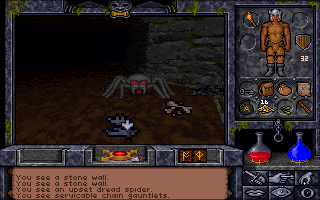 for instance. And if you nuke the keep before it was expected to be nuked, you'll get this
for instance. And if you nuke the keep before it was expected to be nuked, you'll get this
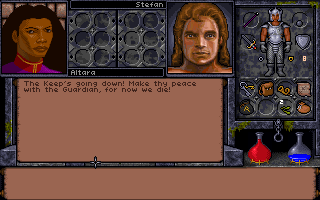
As you may guess, she was a de facto leader of the resistance against the guardian in the Keep.
.
Even factoring in the distaste of writing, gating, and soundtrack, I found the Labyrinth to be better than the Abyss. It has more polish (one of the few games becoming better as the game progresses), it gave me more options as to how to accomplish my aim, it made everything less repetitive with unpredictable environments, and it improved some mechanics of the predecessor. Also, I think it was less of an Ultima since it focused solely on interactivity, dumping the quest structure of older Ultimas along with some non-linearity.

The game had a small overhaul to accommodate formerly useless skills. Search was much more meaningful this time, as buttons, levers, and things of that nature can be missed without it. The swimming sections were longer, as if attempting to make swimming less of a garbage skill, I guess. The player might doom himself with the lack of Lore, as a certain quest item is disposable and very scarce. On the other hand, repair was invalidated by a spell. While money was made a bit more significant with steep prices for certain items or information, it still wasn't a concern - and so charisma and appraise can be disregarded.
Combat-wise, Labyrinth had a few changes, such as the addition of boss encounters, like Three Companions or Dorstag. I adored the fact that they went by the same rules as regular enemies when it made sense - for example, all human enemies could be dispatched rapidly with the Poison Weapon spell. I could use the environment against enemies - for example, I killed a few yetis by luring them towards the thin ice. One unfortunate (albeit seldom important) aspect of the game is the addition of cooldowns for some spells, including magic wands.
This time around, the game featured 8 varied worlds, each with some bit of backstory and at least two things to find. The environments had more quirks - I could slide uncontrollably on ice, I could use (or be forced to use) a trampoline - a lethal endeavour in the world of Talorus, some platforms were moving or disappearing, people reacted to illicit behavior, and traps were more deadly, like the ones on the third level of the Tomb. The platforming became a bit more bearable since the Avatar doesn't fall like a rock anymore after hitting the ceiling. Also, the game became much less compact, and backtracking was a less prominent part of the gameplay. I think this game missed the Gothic-like coziness of the original - I didn't memorize most locations (since I didn't need to), and I couldn't really conquer some environments (as most traps were immutable). Some music tracks were tied to locations, but most were duplicates, and the soundtrack was overall inferior to that of the previous title (also, the main theme was way more cheerful).
There were a few other interesting developments in terms of exploration-related spells. Portal allowed me to faze through walls; gate travel worked on the Mark/Recall principle (since there were two moonstones this time, one teleporting to another). With those few additions and some major changes in level design, the optionality shone far, far brighter than in The Stygian Abyss. In the Ethereal Void, for example, one can solve all four dimensions or circumvent the entire level (except two of the gates for different quests) by using Portal spell while flying up to the shrine. I could avoid a boss fights in the Tomb of Praecor Loth. Concerning the penultimate encounter of the game, I could beat Mors Gotha by destroying the keep she's in. I could get to her room by opening the door (and angering guards) or portalling there and fighting her in isolation. I could start the combat, take the book, and teleport away. Additionally, if I already brutalized the keep,

Given the above, it's disappointing most of the game's content was gated. Even worse, it was gated behind seemingly unrelated plot developments - for example, the last two locations were only available after
Nelson's death


This game went away from the data hunt of previous titles, as the quests became way more shallow - instead of "do X to get Y to give it to Z to get Ω", they had clearly defined start and end. Most of them concern a single area, with no detours needed. I enjoyed the fact that almost every plot-related item is possible to get without solving any of them (since you almost never get them from NPCs). As quests became more straightforward (like finding 8 gems or finding 8 places), the focus shifted from "what to do" to "how to do something". One, however, was completely out of whack - the Basilisk Oil quest.
1) In practice, this item was mentioned once in the game - and I can't ask the quest giver what it is.
2) Turns out, it's a potion - one I can't buy from the potion trader.
3) Apparently, there are four instances of this potion in the entire world.
4) Lore (or Name Enchantment) is needed to identify it.
It was disappointing. I found it while running around the world for hours, searching for things I missed (I expected it to be a quest item or some special flask of oil). It's silly, since quests are far less esoteric than the last time - but this one is way more insane than the spiritual quest from the Stygian Abyss. One thing I enjoyed while searching the world was that a lot of NPCs


Other than that, the game went further with mapping, this time allowing me to copy fragments of found maps (though I disliked how it disallowed me to annotate those fragments), sometimes limiting my ability to map (see Ethereal Void), scarcely changing my position, forcing me to use the Locate spell. Playing as a regular mage was more feasible as the encumbrance limits were higher, and you get ten runes at the start of the game - but hunting the rest of them remained a focal point of the game. Still, like before, I don't think playing with no investments into mana/casting is feasible, since interactivity is centered around spells (unless already knowing what the game has in store for you). While the undergrounds of the castle didn't pull any punches from the start, with reapers, beholders, and headlesses roaming around, the other levels contained challenges homogenous in difficulty, seldom exceeding the Avatar's current abilities - contrary to




As you may guess, she was a de facto leader of the resistance against the guardian in the Keep.
Even factoring in the distaste of writing, gating, and soundtrack, I found the Labyrinth to be better than the Abyss. It has more polish (one of the few games becoming better as the game progresses), it gave me more options as to how to accomplish my aim, it made everything less repetitive with unpredictable environments, and it improved some mechanics of the predecessor. Also, I think it was less of an Ultima since it focused solely on interactivity, dumping the quest structure of older Ultimas along with some non-linearity.
- Joined
- May 13, 2009
- Messages
- 28,841
![The Year of Incline [2014] Codex 2014](/forums/smiles/campaign_tags/campaign_incline2014.png)


Glad to see you enjoyed it.
One of the highpoints of the Underworld-games for me, was how I was proven time and time again that I didn't know everything about the games, that I hadn't found everything and was always discovering something new. In Stygian Abyss, for example, I found a secret room on the fourth floor more than 20 years after I had first played the game. In Labyrinth I finally learned how to get the blackrock serpent in one of my more recent playthroughs (~2016) as well as finally finding a Tracking-trainer.
One aspect where Labyrinth really differs from Abyss is the combat. There are very few difficult combat encounters in the Abyss, but there are tons of them in Labyrinth. Dorstag is by far the hardest opponent in either game, and two combat encounters at the bottom floor of the Pits of Carnage are not to be laughed at. Mors Gotha is only mildly challenging in comparison.
But magic goes a long way towards breaking Labyrinth. The Repair-spell renders a whole skill obsolete, the Enchant Item-spell even more so, and the new Create Food-spell makes food carrying trivial, freeing up valuable space for other stuff... and that's the lighter side of game-breaking spells.
One of the highpoints of the Underworld-games for me, was how I was proven time and time again that I didn't know everything about the games, that I hadn't found everything and was always discovering something new. In Stygian Abyss, for example, I found a secret room on the fourth floor more than 20 years after I had first played the game. In Labyrinth I finally learned how to get the blackrock serpent in one of my more recent playthroughs (~2016) as well as finally finding a Tracking-trainer.
One aspect where Labyrinth really differs from Abyss is the combat. There are very few difficult combat encounters in the Abyss, but there are tons of them in Labyrinth. Dorstag is by far the hardest opponent in either game, and two combat encounters at the bottom floor of the Pits of Carnage are not to be laughed at. Mors Gotha is only mildly challenging in comparison.
But magic goes a long way towards breaking Labyrinth. The Repair-spell renders a whole skill obsolete, the Enchant Item-spell even more so, and the new Create Food-spell makes food carrying trivial, freeing up valuable space for other stuff... and that's the lighter side of game-breaking spells.
behold_a_man
Educated
- Joined
- Nov 26, 2022
- Messages
- 264
Create Food was already present in the first Underworld. It's from the first level, and it's one of the two first spells I used in the Abyss (along with Light). Also, the game was expected to be breakable; it follows from the design notes (penultimate page of the manual, especially section Multiple Solutions).and the new Create Food-spell makes food carrying trivial, freeing up valuable space for other stuff... and that's the lighter side of game-breaking spells.
I could only get Dorstag to yellow before dying, then in some attempt I poisoned my weapon, and the fellow went down in about a dozen hits. For me, the hardest battle was probably Lord Umbria - unlike the encounter with the lich at the bottom of the pit, the room he was in had a high ceiling, so he could use the Mandate-of-Heaven school of abusing enemies and fireballed me from above. I only beat him after luring him into the room that formerly hosted Morphius.Dorstag is by far the hardest opponent in either game, and two combat encounters at the bottom floor of the Pits of Carnage are not to be laughed at. Mors Gotha is only mildly challenging in comparison.
- Joined
- May 13, 2009
- Messages
- 28,841
![The Year of Incline [2014] Codex 2014](/forums/smiles/campaign_tags/campaign_incline2014.png)


Create Food was already present in the first Underworld. It's from the first level, and it's one of the two first spells I used in the Abyss (along with Light).and the new Create Food-spell makes food carrying trivial, freeing up valuable space for other stuff... and that's the lighter side of game-breaking spells.
I know, but it still went through the motion of creating an actual food item in front of the player, and the player had to eat it (or trade it away).
Makes me wonder why they saw a reason to create an updated version of it then.
I do not recall Lord Umbria being a bother, I just closed in immediately and started bashing. Only occasionally was I swinging at the feet, but at least I was connecting blows.
The Dire Reaper was a tough one for me though. Stand too close and it'll smack you dead. Stand too far away and it'll fry you with lightning bolts.
behold_a_man
Educated
- Joined
- Nov 26, 2022
- Messages
- 264
Is there any difference between the two? I still see the food item the same in the Labyrinth. I know Restoration satiates the player immediately, but it's a level 8 spell.I know, but it still went through the motion of creating an actual food item in front of the player, and the player had to eat it (or trade it away).
Makes me wonder why they saw a reason to create an updated version of it then.
Kweepa
Literate
- Joined
- Nov 19, 2024
- Messages
- 23
https://youtu.be/KegyZSGhVMg&t=908
"Some people have commented on how goofy it is that Almric wouldn't give the Avatar any weapons or equipment"
But wait! What's this in the Avatar's left hand in the intro? They must have dropped it just before the game starts...

"Some people have commented on how goofy it is that Almric wouldn't give the Avatar any weapons or equipment"
But wait! What's this in the Avatar's left hand in the intro? They must have dropped it just before the game starts...
chukimomosra
Literate
- Joined
- Oct 15, 2024
- Messages
- 10
The bag is the equipment given to him. If you check inside the bag at the entrance he has a dagger, map and some food and a torch.
Cael
Arcane

- Joined
- Nov 1, 2017
- Messages
- 22,472
The Enchant spell comes with a caveat: Even with max skill, these is still a not insignificant chance you will blow up the item you are trying to enchant, which is nasty if it is the only jewelled sword you have found...Glad to see you enjoyed it.
One of the highpoints of the Underworld-games for me, was how I was proven time and time again that I didn't know everything about the games, that I hadn't found everything and was always discovering something new. In Stygian Abyss, for example, I found a secret room on the fourth floor more than 20 years after I had first played the game. In Labyrinth I finally learned how to get the blackrock serpent in one of my more recent playthroughs (~2016) as well as finally finding a Tracking-trainer.
One aspect where Labyrinth really differs from Abyss is the combat. There are very few difficult combat encounters in the Abyss, but there are tons of them in Labyrinth. Dorstag is by far the hardest opponent in either game, and two combat encounters at the bottom floor of the Pits of Carnage are not to be laughed at. Mors Gotha is only mildly challenging in comparison.
But magic goes a long way towards breaking Labyrinth. The Repair-spell renders a whole skill obsolete, the Enchant Item-spell even more so, and the new Create Food-spell makes food carrying trivial, freeing up valuable space for other stuff... and that's the lighter side of game-breaking spells.
- Joined
- May 27, 2010
- Messages
- 1,586

Fun video retrospective, I like this guy's stuff. Can't wait for the Labyrinth of Worlds video.
Baron Dupek
Arcane
Wait there's no UU2 LoW part of the video? He used to make complete series in one go, but not this one?
The people of Duckburg
Educated
- Joined
- Oct 7, 2024
- Messages
- 128
I was watching that video and had to stop a third of the way through, because I really want to play the game for myself instead. Got into PC gaming relatively late, so I missed several old classics. Is the best version the GoG one, or is there a better one?
- Joined
- May 13, 2009
- Messages
- 28,841
![The Year of Incline [2014] Codex 2014](/forums/smiles/campaign_tags/campaign_incline2014.png)


I think there's only the GoG-version, if other versions exist they're identical.
IIRC the GoG-version had a problem in that it didn't set up its Roland MT-32 settings right, meaning that the music came out all wrong.
But that was years ago, surely it must have been fixed by now.
IIRC the GoG-version had a problem in that it didn't set up its Roland MT-32 settings right, meaning that the music came out all wrong.
But that was years ago, surely it must have been fixed by now.
